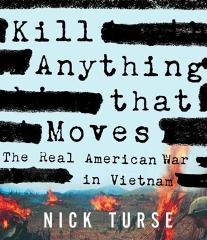1.
Years ago a student offered her honest assessment of a Social Justice class I taught: “You know, the work load in your class is overwhelming…and I tell all my friends that they have to take it.”
Likewise, reading Nick Turse’s Kill Anything That Moves: The Real American War in Vietnam is overwhelming… and you really have to take the time to read it.
For people of a certain age, the linkage of the words “atrocity” and “Vietnam War” means the My Lai massacre of March 1968. In that hamlet, U.S. troops murdered over 500 women, older men, and children. The massacre has been seen by many as an aberration, an oddity, albeit an obscene one.
Turse will have none of this. From interviews with many U.S. veterans as well as Vietnamese survivors, from his poring over the archives of the Army’s own investigations, Turse comes to this conclusion: “the War Crimes Working Group files alone demonstrated that atrocities were committed by members of every infantry, cavalry, and airborne division, and every separate brigade that deployed without the rest of its division—that is, every major army unit in Vietnam.”
Turse doesn’t excuse what the ground forces did, but he does stress that they were acting in response to policy made at the highest levels of the military. The short-hand for the policy was “body-count,” that is, the U.S. could determine its progress by how many Vietnamese enemy corpses it generated. The result: “From the start of the American War to its final years, from the countryside to the cities, Americans relentlessly pounded South Vietnam with nearly every lethal technology in their arsenal short of nuclear weapons, indiscriminately spreading death across vast swaths of territory…. the logic of overkill exacted an immense, almost unimaginable toll on Vietnamese civilians. U.S. commanders wasted ammunition like millionaires, hoarded American lives like misers—and often treated Vietnamese lives as if they were worth nothing at all.”
2.
One veteran said, “We was going to kill anything that we see and anything that moved.”
Another said, “The search-and-destroy mission is just another way to shoot anything that moves.”
One officer said, “So a few women and children get killed… teach ‘em a damned good lesson. They’re all VC or at least helping them… You can’t convert them, only kill them.”
In response to using grenades against children, one soldier said, “Tough shit, they grow up to be VC.”
A general said, “You’ve got to dry up the sea the guerrillas swim in—that’s the peasants—and the best way to do that is to blast the hell out of their villages so they’ll come into our refugee camps.”
One correspondent said, “There were hundreds of these albums in Vietnam, thousands, and they all seemed to contain the same pictures… the severed head shot, the head often resting on the chest of the dead man or being held up by a smiling Marine, or a lot of heads arranged in a row, with a burning cigarette in each of the mouths, the eyes open …the VC suspect being dragged over the dust by a half-track or being hung by his heels in some jungle clearing; the very young dead…a picture of a Marine holding an ear or maybe two ears or, in the case of a guy I knew near Pleiku, a whole necklace made of ears… the dead Viet Cong girl with her pajamas stripped off and her legs raised stiffly in the air…. Half the combat troops in Vietnam had these things in their packs, snapshots were the least of what they took after a fight, at least the pictures didn’t rot.”
3.
William Calley was under house arrest for a few years for his role in the My Lai massacre.
But the architects of the policy that produced a system of misery and mass death got away with it.
Just as the architects of the policy that committed aggression in Iraq and produced a smaller-scale system of misery and mass death have gotten away with it.
It’s unrealistic to think that any U.S. official will ever have to go on trial for his (or her) role in war crimes, crimes against peace, and crimes against humanity.
But in Guatemala the former dictator Efrain Rios Montt is going on trial for genocide and crimes against humanity that occurred in the early 1980s. U.S. President Ronald Reagan was a strong ally of Rios Montt.
How many hours of difficult, dangerous work did how many Guatemalans have to do over how many years to bring Rios Montt to trial?
We have so much to learn from the Vietnamese, the Iraqis, and the Guatemalans.
